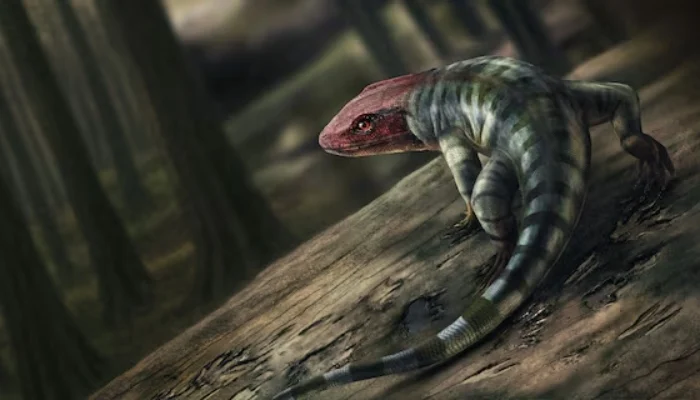Seventeen footprints preserved in a sandstone slab discovered in southeastern Australia, dating back approximately 355 million years, are reshaping the evolutionary timeline of land vertebrates, indicating that reptiles emerged significantly earlier than previously understood.
The fossilized footprints, seemingly imprinted on a muddy ancient riverbank, comprise two distinct trackways and one isolated print. Researchers noted that all exhibit characteristic features of reptile tracks, including their overall shape, toe length, and associated claw marks. They suggest these prints were likely left by a reptile with body dimensions comparable to a lizard.
These findings reveal that reptiles existed around 35 million years earlier than prior evidence suggested, demonstrating a more rapid pace in the evolution of land vertebrates than previously hypothesized.
“So this is all quite radical stuff,” commented paleontologist Per Ahlberg from the University of Uppsala in Sweden, who spearheaded the study published on Wednesday in the journal Nature.
The Australian footprints were found preserved in a sandstone slab measuring about 14 inches (35 cm) across, located on the banks of the Broken River near the town of Barjarg in Victoria.
The story of land vertebrates began with fish venturing out of water, a pivotal moment in Earth’s evolutionary history. These animals were the first tetrapods — meaning “four feet” — and served as the precursors to today’s terrestrial vertebrates: amphibians, reptiles, mammals, and birds. Footprints discovered in Poland, dating to roughly 390 million years ago, represent the oldest fossil evidence of these initial tetrapods, which lived an amphibious existence.
These creatures were the ancestors of all subsequent land vertebrates. Their descendants diverged into two major lineages — one leading to modern amphibians and the other to amniotes, a group encompassing reptiles, mammals, and birds. The amniotes, the first vertebrates to lay eggs on land and thus achieve full independence from aquatic environments, further split into two lineages, one leading to reptiles and the other to mammals. Birds evolved considerably later from reptilian ancestors.
The Australian footprints each measure nearly 1-1.5 inches (3-4 cm) in length. They appear to have been left by three individuals of the same reptile species, with no indications of tail drag or body drag marks. While no skeletal remains were discovered, the footprints offer insights into the physical appearance of the reptile that created them.
“The feet are rather lizard-like in shape, and the distance between hip and shoulder appears to have been about 17 cm (6.7 inches). Of course we don’t know anything about the shape of the head, the length of the neck or the length of the tail, but if we imagine lizard-like proportions the total length could have been in the region of 60 cm to 80 cm (24 to 32 inches),” Ahlberg explained.
“In terms of its overall appearance, ‘lizard-like’ is probably the best guess, because lizards are the group of living reptiles that have retained the closest approximation to the ancestral body form,” Ahlberg added.
The modest size of these earliest reptiles contrasts with some of their later descendants, such as the dinosaurs.
This reptile was likely a predator, as plant-eating behaviors did not emerge until later in reptilian evolution. Herbivorous reptiles tend to have large, bulky bodies, whereas this creature was evidently agile with long, slender toes, Ahlberg noted.
The researchers also described newly identified fossilized reptile footprints from Poland, dating to 327 million years ago, which bear a broad resemblance to those from Australia. These Polish footprints are also older than the previously oldest known evidence for reptiles — skeletal fossils of a lizard-like creature named Hylonomus from Canada, dating to around 320 million years ago, as well as fossil footprints from approximately the same period.
The reptile that left the Australian footprints lived during the Carboniferous Period, a time when global temperatures were similar to today’s, with ice at Earth’s poles but a warm equatorial region. Australia at the time was part of the ancient supercontinent Gondwana and was situated at the southern edge of the tropics. The landscape featured forests, partly composed of giant clubmoss trees.
“The tracks were left near the water’s edge of what was probably quite a large river, inhabited by a diversity of big fishes,” Ahlberg concluded.



